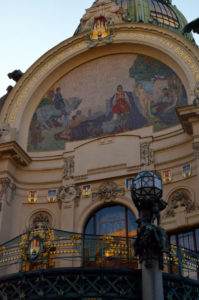The Prague Personality
 Prague in the Czech Republic has an interesting, complex personality. Prague has been called the “City of a Hundred Spires.” It is also a city with history, plenty of art, and a sense of humour.
Prague in the Czech Republic has an interesting, complex personality. Prague has been called the “City of a Hundred Spires.” It is also a city with history, plenty of art, and a sense of humour.
We chose to use a personal tour guide and Airbnb in Prague. Both proved good choices.
Prague is a walking town if you can call a city of 1.3 million people a town. Tourists can walk to see Old Town, New Town, and the Jewish Quarter. The Jewish Quarter is closed Saturdays and many museums are closed on Mondays. Tourists often want to see Prague Castle, Charles Bridge (which is crowded), and perhaps the astronomical clock.
Renata, our guide was excellent; she toured us two half-days. When we asked about the crowds in the streets, Renata told us that September was prime tourist time. July was much quieter. With her help, we used the tram and the metro to reduce some walking distances. Most days we walked ten or more kilometres.
One major attraction is the variety of architecture. Generally, Prague was not bombed during World War II, so Romanesque buildings from 800 to the mid-13th century, Gothic architecture influenced by Charles IV, Renaissance structures from the 15th century, and Baroque architecture from the 17th century cause Prague to appear on the UNESCO World Heritage List.
Some buildings are decorated with Art Nouveau from the 19th and 20th centuries, so we saw painted flowers, leaves and beautiful women on some structures, thanks in part to the influence of Alfons Mucha. Later we visited a small museum dedicated to displaying some of his art.
Squeezed between tours was a Sunday tour to UNESCO-listed Cesky Krumlov. When we arrived after a three-hour drive through busy Sunday traffic, a walk through an attractive park brought us to views of the medieval town, with towers and steeples peering out through a fairy-tale mass of red roofs. The town is enclosed within a bend of the Vltava River. Its beauty invites walking, and it is natural to tour the castle. The most interesting room in the castle is the masquerade ballroom where a hard-working artist created masked character after character along the walls. Visit Cesky Krumlov on a weekday!
A story of the area told of a man who wanted money and decided to get it by marrying his daughter to a noble. Unfortunately, the noble also sought money and neither man got it. For revenge, the not-so-noble man imprisoned his new wife, periodically with no food or water. Time passed and when the man grew ill he asked his wife to forgive him. When she refused, he cursed her, which is why their castle has a ghost. The guide said he knew someone who worked there “for a hundred years” and never saw the ghost.
In Prague one may hear a story from Jewish folklore, the story of the Golem, a being that is created from mud or clay. The Golem was brought to life to save the Prague ghetto from pogroms, which it did. However, one version of the story says that, when rejected for love the Golem turned destructive. The story gives the Golem a wide variety of symbolic possibilities: was the Golem victim or villain?
Prague grew from independent towns. A sense of history provides context. Prague Castle is dated 880. One of the squares in Prague is Wenceslas Square, named for the beloved patron saint, known today through the Christmas classic, “Good King Wenceslas.” Old Town is associated with 1239; New Town appeared in 1348, in what is called the Golden Age. This era is associated with Charles IV, the man for whom Charles Bridge is named. The Jewish Quarter developed in the 17th century. The 18th century is associated with baroque influence; the 19th century saw the rise of Czech literature and the nationalist movement.
In the 20th century, the assassination of Archduke Frances Ferdinand in Sarajevo initiated World War I. 1939 saw the German occupation; in 1945, Soviet tanks reached Prague; the communist coup followed in 1948. The Velvet Revolution of 1989 quietly freed Czechoslovakia of Soviet influence. In 1993, the split of Czechoslovakia produced the Czech Republic. In 2004, The Czech Republic became a member of the European Union but kept its own currency, the koruna (think “crowns”). Guides refer to history with pride.
Art is everywhere, some of it influenced by the writing of Franz Kafka who made absurdity significant and philosophical. Visitor can see a house that appears to be dancing and a giant skeletal hand. Artist David Cerny created a metallic Kafka head, the parts of which rotate and shift segment by segment. Cerny combines satire and absurdity in many of his sculptures such as an upside-down horse suspended from a ceiling. He added giant babies crawling up the television tower which is the tallest, and ugliest, structure in Prague. Prague is a city with history and culture––but it is also a city with a spirit of adventure.
All Posts

